
by Beth Bolles | Oct 7, 2016
The year’s mild winter and frequent rain showers have created lush lawns and gardens with an abundance of insects. As a result, we are seeing many predator arthropods taking advantage of the available feast. One of the morning interesting creatures in the garden is the spiny orb weaver spider (Gasteracantha cancriformis) that has an interesting body shape.
Spiny orb weavers are common spiders in landscapes that might not be noticed since they are much smaller than the Yellow garden spider (Argiope aurantia) and the Golden silk spider (Nephila clavipes). Once viewed, the spiny orb weaver will catch your attention because it’s abdomen has six ‘spines’ or points that extend out. Spiders also have a mix of yellow, white, red, or black marking on the abdomen.
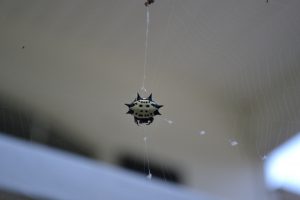
Spiny orb weaver in the center of the web waiting for a meal. Photo by Beth Bolles
Although spiders are small, the webs which are common amongst shrubs, trees, and edges of woods become quite substantial in the fall. There may be up to 30 spirals that extend out with the spider situated in the center. You may unexpectedly encounter a web when walking through the garden or mowing around trees and shrubs. There is no worry if a spider accidently gets on you as bites are not common and not considered serious.
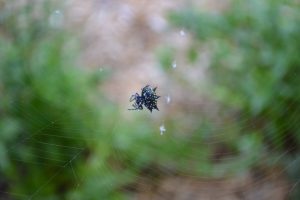
Spider working on her web. Photo by Beth Bolles
Some may refer to the spiny orb weaver as a crab spider based on its shape, but it is a web building where the true crab spiders are active hunters often found resting on flowers in order to ambush a meal.
Enjoy our fall weather and look out for this beneficial spider in your landscape.
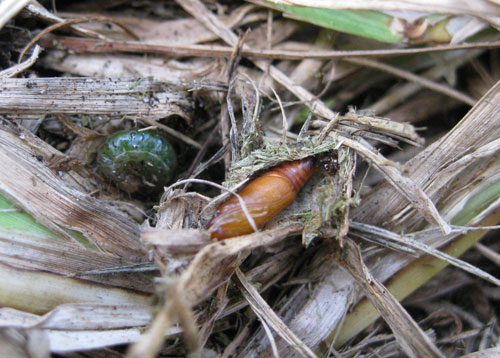
by Matt Lollar | Sep 29, 2016
Tropical sod webworms (Herpetogramma phaeopteralis) have recently been encountered in a number of yards in the Panhandle. The worms usually feed in large groups and unfortunately, the first, and basically the only, sign of damage is often a large area of shorter grass due to their feeding. The arrival time of sod webworms is also unfortunate because they are part of a group of caterpillars that successively attack turf including fall armyworm (Spodoptera frugiperda), striped grass loopers (Mocisspp.), and the fiery skipper (Hylephila phyleus).
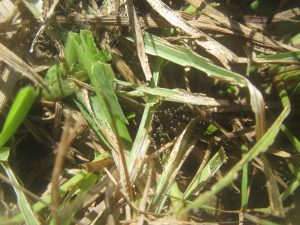
Sod webworm feeding damage in the turf thatch layer. Photo Credit: University of Florida/IFAS Extension.
Description
Larvae
Caterpillars are light yellow to orange with brown spots on each body segment and they have a dark, orange-brown head. They will grow to a full length of slight less than 1/2 inch.
Pupae
The reddish brown pupae are about about 1/4 inch long. The pupae are typically found in the upper thatch layer.
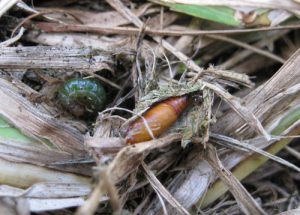
Pupa found in cocoon in St. Augustinegrass thatch. Photo Credit: Steven Arthurs, University of Florida/IFAS
Adults
The moths brown with splotchy wings and are about 3/4 inch wide.
Control
Sod webworms are difficult to control because of their spontaneity. However, in the lawn they hide in the thatch during the heat of the day. Over watering and fertilization can increase the amount of thatch. It is important to follow UF/IFAS guidelines for home lawn management.
The first line of defence is healthy turf. Proper fertilization, irrigation, and mowing height can decrease susceptibility of turfgrass against sod webworm. Over-fertilization is a common cause of caterpillar outbreaks in lawns. Cultural practices such as thatch removal by vertical mowing can help eliminate populations. Eggs are laid on grass blades and removal of grass clippings might also reduce populations.
Numerous chemical control options are available, but softer chemicals such as insecticides containing the bacteria Bacillus thuringiensis are recommended as a first line of defense. Insecticides should be applied in the morning or evening during feeding time. For additional control strategies and basic information please visit the UF/IFAS Sod Webworm Publication.

by Matt Lollar | Sep 8, 2016
Plants can become distorted for a wide variety of reasons. Sometimes nutrient deficiencies or toxicities can cause plants to become distorted. Sometimes excessive amounts of water or sunlight can cause plants to become distorted. And sometimes insect feeding damage can be the culprit.
Insects can cause plant mutations by feeding alone or by vectoring disease from one plant to another. The most recent and most detrimental example of insects vectoring disease is the Asian Citrus Psyllid, which has distributed Huanglongbing, also known as citrus greening, to most of the citrus acreage in Florida and across the United States. Fortunately, the panhandle is currently free from this detrimental disorder. However, we still have a plethora of insects that distort plants by one way or another. One group of plant altering insects are commonly known as planthoppers.
Planthopper adults range in size between 1/8 to 1/4 inches long. They are slender and frequently have an angular, pointed head. Coloration depends on species, but generally planthoppers are of green, brown, or white. Immatures look similar to the adults except they are smaller and don’t have wings. Immatures typically feed on the underside of leaves, where the humidity is higher and they are more protected from predators.

Three growth stages of planthoppers. Photo Credit: UF/IFAS Extension
Planthoppers feed on plant leaves and shoots by sucking out the contents. The damage that ensues from feeding depends on the host plant and the hopper species. A few species of hoppers transmit pathogens that can alter plant growth. Usually, adult hoppers are pests only when found in high numbers.
Feeding damage from some species causes small white spots (stippling) to appear on the upper leaf surface, usually beginning near the leaf midrib. Stippled areas eventually merge together into larger whitish blotches. In some plants, feeding damage causes a drying and yellowing (or browning) of leaf tips and some planthopper species cause curling or stunting of newly formed leaves. Oftentimes, white, papery skin castings will remain from the molting process on the undersides of leaves.
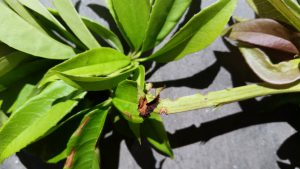
Planthopper feeding damage on sweet olive. Photo Credit: UF/IFAS Extension
Planthoppers are rarely present in large enough numbers to cause significant plant damage. Fortunately, planthoppers have many natural enemies including lady beetles, lacewings, damsel bugs, and spiders. Sticky traps are recommended to help monitor planthopper populations. Planthoppers are usually attracted to yellow sticky traps that can be placed among the plant leaves. Small populations can be managed using these traps. If greater populations are present, then insecticidal soap can control young planthoppers. Make sure to spray both the top and underside of the leaves.
Planthoppers are minor pests in the landscape, but they can cause alarming mutations in plant material. Contact your local Extension Office for help with diagnosis and treatment options.
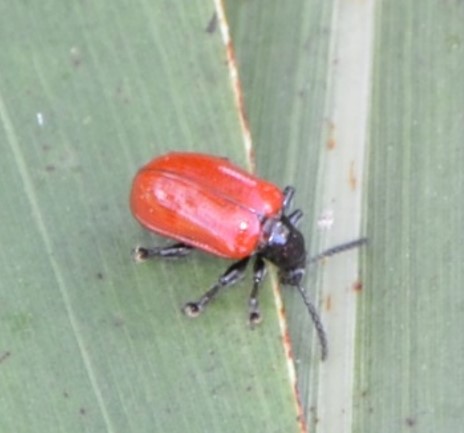
by Les Harrison | Aug 23, 2016
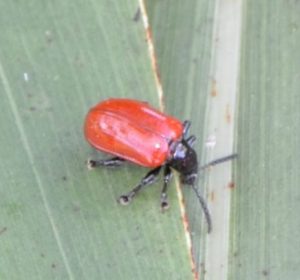
Air potato leaf beetle. Photo credit: Les Harrison, UF/IFAS.
A small, but brightly colored beetle has appeared in north Florida: the air potato leaf beetle (Liliocetis cheni), a native of East Asia. The beetle, less than half an inch long, has a candy apple red body that stands out against green leaves and the more muted earth tones of most other bugs. The striking bright glossy red coating would be the envy of any sports car owner or fire truck driver.
Unlike other arrivals to the U.S., this insect was deliberately released in 2012 for biological control of air potato. After years of testing, approval was finally given to release air potato leaf beetles to begin their foraging campaign against this invasive plant species. The beetle has very specific dietary requirements and only can complete its life cycle on air potato. The larvae and adults of this species consume the leaf tissue and occasionally feed on the tubers.
When a population of air potato leaf beetles finish off an air potato thicket, they go in search of nourishment from the next patch of air potato. They are sometimes seen during stopovers while in search of their next meal.
Air potato (Dioscorea bulbifera) is an herbaceous perennial vine which is easily capable of exceeding 60 feet in length. It quickly will climb over any plant, tree or structure unfortunate enough to be in its vicinity. The vine also produces copious quantities of potato-like tubers suspended from its vines. Unless collected and destroyed, most of the easily camouflaged potatoes will germinate and intensify the infestation.
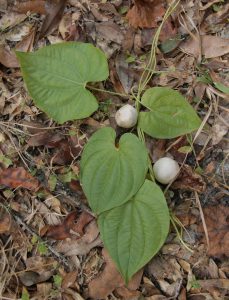
Air potato. UF/IFAS Photo: Thomas Wright.
Air potato came to Florida in 1905 from China and quickly escaped into the wild. By the 1980’s it was a serious pest species in south and central Florida, but has gradually become established in the panhandle, too. Chemical control of the air potato has been difficult. Repeated herbicide treatments are required to kill a thicket with multiple plants.
Unlike the air potato leaf beetle that only eats air potato, kudzu bugs eat their namesake vine (kudzu), but also feed on a number of other plants including a wide selection of valuable legumes and be quite destructive. Kudzu bugs were accidently introduced in north Georgia in 2009 and have spread across the south in the ensuing years and become established in north Florida.
It is a pleasant surprise to know air potato leaf beetles are working to limit the invasive air potato vine, but it is sad to think there is plenty more for them to eat.
To learn more about the air potato and the beetle:
Natural Area Weeds: Air Potato (Dioscorea bulbifera)
Air Potato Leaf Beetle Publication

by Ray Bodrey | Aug 19, 2016
Being a gardener in the panhandle has its advantages. We’re able to grow a tremendous variety of vegetables on a year-round basis. However, in this climate, plant diseases, insects and weeds can often thrive. Usually, chemical measures are applied to thwart these pests. Some panhandle gardeners are now searching for techniques regarding a more natural form of gardening, known as organic. With fall garden planting just ahead, this may be an option for conventional vegetable gardeners looking for a challenge.

Vegetable Garden at UF/IFAS Extension Wakulla County. Photo credit: Ray Bodrey UF/IFAS.
So, what is organic gardening? Well, that really depends on who you ask. A broad definition is gardening without the use of synthesized fertilizers and industrial pesticides. Fair warning, “organic” does not translate into easier physical gardening methods. Laborious weeding and amending of soil are big parts of this gardening philosophy. This begs the question, why give up these proven industrial nutrient and pest control practices? Answer: organic gardening enthusiasts are extremely health conscious with the belief that vigorous outdoor activity coupled with food free of industrial chemicals will lead to better nutrition and health.
As stated earlier, the main difference between conventional and organic gardening is the methods used in fertilization and pest control. In either gardening style, be sure to select a garden plot with well-drained soil, as this is key for any vegetable crop. Soil preparation is the most important step in the process. To have a successful organic operation, the garden will require abundant quantities of organic material, usually in the form of animal manures and compost or mixed organic fertilizer. These materials will ensure water and nutrient holding capacity. Organic matter also supports microbiological activity in the soil. This contributes additional nutrients for plant uptake. Organic fertilizers and conditioners work very slowly. The vegetable garden soil will need to be mixed and prepped at least three weeks ahead of planting.
Effective organic pest management begins with observing the correct planting times, selection of the proper plant variety and water scheduling. Selecting vegetable varieties with pest resistant characteristics should be considered. Crop rotation is also a must. Members of the same crop family should not be planted repeatedly in the same organic garden soil. Over watering can be an issue. Avoid soils from becoming too wet and water only during daylight hours.
For weed management, using hand tools to physically removing weeds is the only control method. As for insect management, planting native plants in the immediate landscape of the organic garden will help draw in beneficial insects that will feast on garden insect pests. The use of horticultural oil or neem oil is useful. However, please read the product label. Some brands of oils are not necessarily “organic”. Nematodes, which are microscopic worms that attack plant roots, are less likely an issue in organic gardens. High levels of organic matter in soil causes an inhospitable environment for nematodes. Organic disease management unfortunately offers little to no controls. Sanitation, planting resistant varieties and crop rotation are the only defense mechanisms. Sanitation refers to avoiding the introduction of potential diseased transplants. Disinfecting gardens tools will also help. Hydrogen peroxide, chlorine and household bleach are disinfecting chemicals allowed in organic gardening settings as these chemicals are used in organic production systems for sanitation. Staking and mulching are also ways to keep plants from diseases by avoiding contact with each other and the soil.
Organic gardening can be a challenge to manage, but better health and nutrition could be the reward. Please take the article recommendations into consideration when deciding on whether to plant an organic garden. For more information, contact your local county extension office.
Supporting information for this article can be found in the UF/IFAS EDIS publication, Organic Vegetable Gardening in Florida, by Danielle D. Treadwell, Sydney Park Brown, James Stephens, and Susan Webb.

by Sheila Dunning | Aug 19, 2016
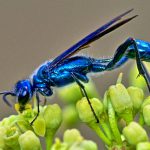 With all the media discussion of “bad” insects, like mosquitoes, many of the good guys are forgotten. One that has been very active this summer is the blue mud dauber, Chalybion californicum. These wasps are metallic blue, blue-green or blackish in color with very short narrow waists. During the summer, female blue mud daubers build nests by bringing water to abandoned mud nests made by other species of mud dauber wasps. They form new mud chambers, stock them with paralyzed spiders and a single egg, then seal the chambers with more mud. Their offspring stay in the chamber, feeding on the spiders, and then pupate in a thin silk cocoon. They spend the winter in the nest, emerging the following spring as adults.
With all the media discussion of “bad” insects, like mosquitoes, many of the good guys are forgotten. One that has been very active this summer is the blue mud dauber, Chalybion californicum. These wasps are metallic blue, blue-green or blackish in color with very short narrow waists. During the summer, female blue mud daubers build nests by bringing water to abandoned mud nests made by other species of mud dauber wasps. They form new mud chambers, stock them with paralyzed spiders and a single egg, then seal the chambers with more mud. Their offspring stay in the chamber, feeding on the spiders, and then pupate in a thin silk cocoon. They spend the winter in the nest, emerging the following spring as adults.
Blue mud daubers are solitary wasps and not known to be aggressive. When the females have carried water to an old black and yellow mud dauber’s nest, she softens it and remolds it to her needs. The result is a very lumpy version of the originally smooth nest. Next she must fill the nest with food for her future offspring. The blue mud dauber prays on spiders.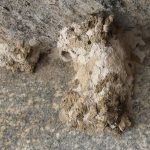
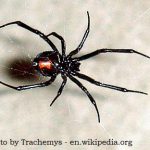 If orb weavers, lynx or crab spiders are plentiful, the blue mud dauber is able to land on their web without getting entangled and pluck the web to simulate an insect in distress. When the spider rushes to capture its prey, the poor arachnid becomes the victim of the wasp’s paralyzing sting and is quickly flown to the mud nest. However, the preferred host of the blue mud dauber is the southern black widow. Even without the elaborate web game, this wasp can control a dangerous nuisance. Once at the nest with her spider victim, the blue mud dauber stores the paralyzed arachnid at the bottom of a mud cell and lays a single egg onto its body. When the wasp larva hatches it consumes the remaining body of the spider. With a full belly, the mature larva spins a papery silken cocoon within the mud nest and begins to pupate. The following spring an adult wasp chews a round hole in the end of the mud cell and exits it’s winter home.
If orb weavers, lynx or crab spiders are plentiful, the blue mud dauber is able to land on their web without getting entangled and pluck the web to simulate an insect in distress. When the spider rushes to capture its prey, the poor arachnid becomes the victim of the wasp’s paralyzing sting and is quickly flown to the mud nest. However, the preferred host of the blue mud dauber is the southern black widow. Even without the elaborate web game, this wasp can control a dangerous nuisance. Once at the nest with her spider victim, the blue mud dauber stores the paralyzed arachnid at the bottom of a mud cell and lays a single egg onto its body. When the wasp larva hatches it consumes the remaining body of the spider. With a full belly, the mature larva spins a papery silken cocoon within the mud nest and begins to pupate. The following spring an adult wasp chews a round hole in the end of the mud cell and exits it’s winter home.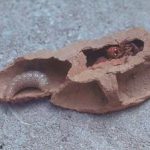
As adults, the blue mud dauber feeds on nectar from flowers and honeydew secreted by insects. Should you encounter a large congregation of this normally solitary wasp, don’t be alarmed. It is probably just a bunch of male blue mud daubers gathering together to sleep it off, after a heavy day of “drinking.”
So, rather than having to cover yourself in DEET just to spend the evening on the patio, brave the heat (with water bottle in hand, of course) and spend the daytime hours watching the blue mud daubers prepare their nest for next year’s young. Maybe the media will pick up on wasp that are reducing black widow populations, rather than the dangers of mosquitoes.



















